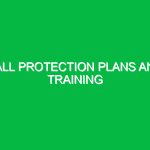Roof work is an essential part of construction and maintenance, but it also comes with its own set of risks and hazards. Whether you are a seasoned roofer, a contractor, or a homeowner tackling a DIY project, understanding roof work safety precautions is crucial. These precautions not only protect the individuals working at heights but also ensure compliance with Health, Safety, and Environment (HSE) standards. In this article, we will dive deep into the potential hazards associated with roof work, explore actionable safety precautions, and outline the regulations governing this vital aspect of the construction industry.
Understanding Roof Work Safety Precautions
Roof work safety precautions encompass a wide range of strategies aimed at preventing accidents and injuries while working on roofs. These precautions are rooted in the HSE framework, which seeks to safeguard the health and well-being of workers. According to the Health and Safety Executive (HSE), falls from heights remain one of the leading causes of fatalities and serious injuries in the construction sector. Thus, implementing effective safety measures is not just a regulatory requirement; it is a moral responsibility.
From the moment a worker steps onto a roof until the job is complete, various safety protocols must be in place. This ranges from the use of personal protective equipment (PPE) to the establishment of secure work practices. To effectively navigate these challenges, it is imperative to recognize the potential hazards that can arise during roof work.
Identifying Hazards and Risks in Roof Work
As with any construction activity, roof work presents multiple hazards that can lead to accidents. Below are some of the most common risks associated with working on roofs:
1. Falls from Heights
Falls are the predominant risk in roof work. According to the Occupational Safety and Health Administration (OSHA), nearly 34% of fatalities in the construction industry are due to falls. Slippery surfaces, unguarded edges, and unstable ladders can all contribute to these accidents.
2. Electrical Hazards
Working near power lines poses a significant risk. Accidental contact with live wires can lead to severe injuries or even fatalities. Additionally, using electric tools on wet surfaces can increase the risk of electrocution.
3. Weather Conditions
Adverse weather conditions, including rain, snow, or high winds, can make roof work extremely hazardous. Wet surfaces increase the likelihood of slips, while high winds can destabilize ladders and scaffolding.
4. Material Handling
Roofing materials, such as shingles and tiles, can be heavy and cumbersome. Improper lifting techniques can lead to musculoskeletal injuries, and unsecured materials can fall, posing risks to individuals below.
5. Lack of Training
Inadequate training can exacerbate the risks associated with roof work. Workers who are not familiar with safety protocols may not know how to use equipment properly or recognize potential hazards.
Implementing Safety Precautions: Best Practices for Roof Work
With an understanding of the hazards, the next step is to implement effective safety precautions. Here are some best practices that can significantly reduce the risk of accidents:
1. Use of Personal Protective Equipment (PPE)
PPE is the first line of defense against injuries. Essential gear for roof work includes:
- Hard Hats: Protect against falling objects.
- Safety Harnesses: Essential for fall protection, particularly when working on steep roofs.
- Non-slip Footwear: Helps prevent slips and falls.
- Gloves: Protect hands from sharp materials.
2. Fall Protection Systems
Establishing a reliable fall protection system is critical. This can include guardrails, safety nets, and personal fall arrest systems (PFAS). It’s vital that these systems are installed correctly and inspected regularly.
3. Proper Ladder Safety
Ladders are commonly used in roof work, but they can be a source of falls if not used properly. Always ensure:
- The ladder is stable and on a firm surface.
- It is positioned at a 75-degree angle.
- Ladders are inspected before use for any damage.
4. Weather Monitoring
Before starting any roof work, check the weather forecast. Avoid working in high winds, rain, or snow. If weather conditions change suddenly, have a plan in place to safely secure tools and materials and exit the roof.
5. Comprehensive Training Programs
Investing in training for all workers is essential. Training should cover the proper use of equipment, recognition of hazards, and emergency response procedures. Regular refresher courses help keep safety at the forefront.
Real-Life Example: Learning from Experience
A few years ago, I attended a roofing workshop where a seasoned contractor shared a harrowing experience. He recounted a time when a team member fell from a roof because they were not using a harness. The individual suffered serious injuries, leading to a lengthy recovery period. This incident deeply impacted the entire crew’s approach to safety. They implemented mandatory harness usage and regular safety drills, which have since led to a remarkable decrease in accidents.
Regulations and Standards Governing Roof Work Safety
Several regulations govern roof work safety, ensuring that both employers and employees adhere to best practices. Key regulations include:
1. OSHA Standards
The Occupational Safety and Health Administration sets forth regulations specifically for fall protection, scaffolding, and ladder safety. Employers are legally obligated to follow these standards to ensure a safe working environment.
2. National Fire Protection Association (NFPA)
The NFPA provides guidelines on electrical safety, particularly in roofing work where electrical hazards are present. Compliance with these regulations can prevent electrocution incidents.
3. Local Building Codes
In addition to federal regulations, local building codes often provide additional safety measures that must be adhered to. These codes are designed to ensure that construction practices meet community safety standards.
Conclusion: Prioritizing Safety in Roof Work
Roof work safety precautions are not just a set of guidelines; they are a fundamental aspect of ensuring the well-being of workers and the successful completion of projects. By identifying potential hazards, implementing best practices, and adhering to relevant regulations, we can create a safer working environment for everyone involved. The importance of safety cannot be overstated, and it is a responsibility that must be taken seriously at every level of the construction industry. Remember, safety is not just a priority; it is a culture that must be fostered and maintained.


